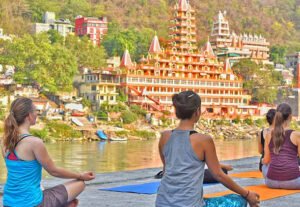Month: June 2025
meditation and yoga
 Meditation and yoga are two powerful and interconnected natural healing practices that promote physical, mental, and emotional well-being. They have been used for thousands of years and are increasingly supported by modern science for their benefits.
Meditation and yoga are two powerful and interconnected natural healing practices that promote physical, mental, and emotional well-being. They have been used for thousands of years and are increasingly supported by modern science for their benefits.
🧘♂️ Yoga: A Union of Body and Mind
🔹 What is Yoga?
Yoga is a holistic discipline from India that combines physical postures (asanas), breathing techniques (pranayama), meditation, and ethical living to achieve harmony between body and mind.
🔹 Benefits of Yoga
Physical: Improves flexibility, strength, posture, and balance
Mental: Reduces anxiety, depression, and stress
Health: Aids digestion, boosts immunity, lowers blood pressure
Energy: Balances energy flow (chakras), enhances vitality
🔹 Types of Yoga
Hatha Yoga – Gentle and basic; great for beginners
Vinyasa – Flow-based; connects movement with breath
Ashtanga – More athletic and structured
Yin Yoga – Slow, deep stretching; focuses on connective tissue
Restorative Yoga – Deep relaxation, supported poses
Kundalini – Awakens energy through breath, mantra, and movement
🧘♀️ Meditation: Inner Stillness & Clarity
🔹 What is Meditation?
Meditation is the practice of focusing the mind and training awareness to achieve mental clarity, emotional calm, and a deeper connection with the present moment.
🔹 Benefits of Meditation
Mental: Reduces stress, anxiety, and overthinking
Emotional: Increases resilience, self-awareness, and positivity
Cognitive: Improves concentration, memory, and decision-making
Physical: Can reduce blood pressure, improve sleep, and lower inflammation
🔹 Types of Meditation
Mindfulness Meditation – Observing thoughts and sensations without judgment
Loving-Kindness (Metta) – Cultivating compassion for self and others
Body Scan – Progressive awareness of body parts to release tension
Mantra Meditation – Repeating a word or sound (e.g., “Om”) for focus
Breath Awareness – Focusing on the inhale and exhale
Transcendental Meditation – Silent repetition of a mantra for 20 minutes
🧘♂️ Yoga & Meditation Together
Many yoga classes end with meditation or savasana (relaxation pose), combining movement with mental stillness. Together, they:
Align physical health with mental peace
Deepen self-awareness
Improve emotional balance
Build a consistent wellness routine
🕯️ How to Get Started
🗓️ Beginner Routine
Daily (15–30 mins):
5–10 minutes of gentle yoga stretches
5 minutes of mindful breathing
10 minutes of seated or guided meditation
Natural healing therapy
Arogya Natural healing therapy refers to a wide range of practices and treatments that aim to support the body’s ability to heal itself, often using non-invasive and holistic methods. These therapies typically focus on the mind-body connection, nutrition, herbal remedies, energy flow, and lifestyle adjustments.
🌿 Common Types of Natural Healing Therapies
1. Herbal Medicine
Use of plant-based remedies (e.g., chamomile for sleep, turmeric for inflammation).
Common in Ayurvedic and Traditional Chinese Medicine (TCM).
2. Naturopathy
Combines natural therapies like nutrition, herbal medicine, and homeopathy.
Naturopathic doctors (NDs) often provide holistic care and lifestyle coaching.
3. Acupuncture
Involves inserting thin needles into specific points on the body to restore energy flow (Qi).
A key part of TCM, often used for pain relief and stress.
4. Chiropractic Care
Focuses on spinal alignment and nervous system health.
Often used to treat musculoskeletal issues.
5. Massage Therapy
Manipulates muscles and soft tissues to reduce tension, improve circulation, and enhance relaxation.
6. Aromatherapy
Uses essential oils from plants to improve physical and emotional well-being.
Commonly used in diffusers, massage oils, or baths.
7. Mind-Body Techniques
Includes yoga, meditation, tai chi, and breathing exercises.
Aims to reduce stress, improve mental clarity, and support healing.
8. Homeopathy
Based on the principle of “like cures like.”
Involves highly diluted substances to trigger the body’s healing response.
9. Dietary Therapy
Focuses on eating whole, unprocessed foods that nourish the body.
May include detox diets, elimination diets, or traditional systems like the Mediterranean or Ayurvedic diet.
10. Energy Healing
Practices like Reiki or Qi Gong work with the body’s energy fields to promote balance and health.
✅ Benefits
Few side effects (when done properly).
Emphasizes prevention and lifestyle.
Often complements conventional medical treatments.
⚠️ Things to Keep in Mind
Effectiveness varies; not all natural therapies are scientifically proven.
Some herbal or natural treatments can interact with medications.
Always consult with a healthcare professional, especially if you have a chronic condition or are pregnant.
Neurotherapy in Haridwar
🧠 Neurotherapy in Haridwar
Healing Through the Power of the Nervous System
In recent years, neurotherapy in haridwar has gained increasing attention as a natural and non-invasive method for treating a wide range of physical and mental health issues. Rooted in ancient Indian wisdom and refined by modern techniques, neurotherapy is now making its mark in spiritual cities like Haridwar, where tradition and holistic healing go hand in hand.

🌿 What is Neurotherapy?
Neurotherapy (also known as neurophysiological therapy) is a system of treatment that focuses on the nervous system and its role in regulating bodily functions. By applying pressure to specific nerve points, it helps the body restore its natural chemical balance, improve organ function, and heal from within — without the use of drugs or surgery.
Common Conditions Treated:
Migraine and chronic headaches
Joint and back pain
Hormonal imbalances
Stress, anxiety, and depression
Digestive issues
Sleep disorders
🏞️ Why Haridwar?
Haridwar, with its spiritual aura and natural surroundings, offers the perfect backdrop for healing. People from across India come to the city seeking wellness — not just spiritually, but physically and mentally as well.
The availability of experienced neurotherapists, coupled with the city’s emphasis on holistic living, makes Haridwar a growing hub for natural and integrative healthcare.
🏥 Leading Neurotherapy Centers in Haridwar
Arogya Neurotherapy and Yoga Training Centre
Services: Neurotherapy, spinal therapy, migraine treatment, yoga
Location: Shivalik Nagar, Haridwar
Contact: +91 6396200548
Website: arogyaneurotherapy.com
🙌 Benefits of Choosing Neurotherapy
✅ 100% Natural and Drug-Free
✅ Personalized, Root-Cause Approach
✅ No Side Effects
✅ Complements Other Therapies Like Ayurveda and Yoga
✅ Helps Restore Long-Term Wellness
🧘 Final Thoughts
Whether you’re struggling with a chronic ailment or looking to enhance your overall well-being, neurotherapy in Haridwar offers a deeply healing experience — one that’s grounded in nature, tradition, and the body’s own ability to restore itself.
If you’re visiting Haridwar or live nearby, consider exploring this unique form of therapy and discover what true balance feels like — mentally, physically, and emotionally.
yoga & exercise
Yoga & Exercise: The Perfect Duo for Body and Mind Wellness
In today’s fast-paced world, the need for physical strength and mental clarity has never been greater. While traditional exercise builds endurance, strength, and cardiovascular health, yoga nurtures flexibility, balance, and inner calm. When combined, yoga and exercise create a powerful synergy that supports total wellness — both insid
e and out.
Why Combine Yoga & Exercise?
1. Balanced Fitness
While workouts like weight training or running target muscle strength and stamina, yoga enhances flexibility and core stability. This balance helps prevent injuries and improves overall performance in any physical activity.
2. Improved Recovery
Yoga promotes blood flow, reduces muscle tension, and encourages relaxation — perfect for recovery days. A short yoga session after a workout can ease soreness and speed up healing.
3. Mental Focus
Exercise boosts endorphins, but yoga takes it further by calming the nervous system. The breath control and mindfulness in yoga help reduce stress, improve focus, and promote better sleep.
4. Sustainable Lifestyle
Combining yoga and exercise creates a routine that is energizing yet sustainable. You’re less likely to burn out when your routine includes days of active rest and mindful movement.
How to Build a Balanced Routine
Here’s a sample weekly plan blending both:
| Day | Activity |
|---|---|
| Monday | Strength training + 15 mins yoga cool-down |
| Tuesday | Morning yoga flow (30 mins) |
| Wednesday | Cardio (run, bike, HIIT) |
| Thursday | Power yoga or Pilates |
| Friday | Upper body workout + stretching |
| Saturday | Gentle yoga (restorative or yin) |
| Sunday | Rest or light walk + breathwork |
Top Tips to Get Started
🧘♀️ Start small – Even 10–15 minutes of yoga can make a difference.
🏋️ Don’t skip warm-ups and cool-downs – Yoga can serve as both.
🎧 Use apps or online videos to guide you.
📅 Schedule it – Treat yoga and workouts like important meetings.
💧 Stay hydrated and eat to fuel your body.
Final Thoughts
Yoga and exercise don’t need to compete — they complement each other beautifully. While one builds physical strength and endurance, the other cultivates awareness, recovery, and flexibility. Together, they support a lifestyle that promotes longevity, vitality, and peace of mind.
Move your body, calm your mind, and let your routine work for you.





